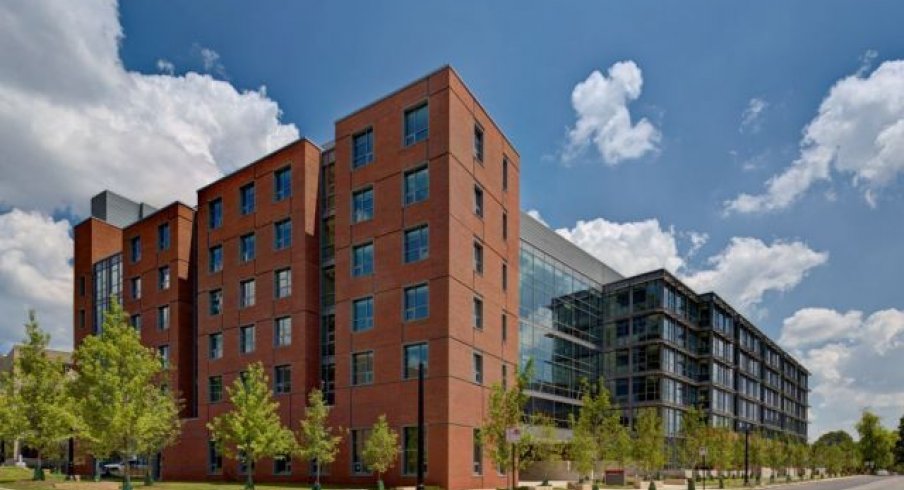Facilities have always factored into recruits’ decision making. But the definition of facilities has become broader on 21st century college campuses that include opulent dorm rooms. More and more, athletes are putting added important on living quarters when deciding where to spend their next four years.
In a 2013 survey conducted by Galain Solutions, 179 college football players were polled on a series of factors that contributed to their college choice. Campus living facilities ranked as the sixth most important indicator – and universities have taken notice.
A majority of Ohio State’s freshmen and sophomore football and basketball players, who have elected not to live off campus, live in the Worthington Building or the Residence on 10th. Both structures are appealing to the eye from inside and outside, built in the past decade, and located near the Younkin Success Center and Marketplace. The Worthington Building is a five-story dorm that consists of four-person apartment style rooms that include two bedrooms, two bathrooms, a kitchen and a common area.
The Residence on 10th, completed last year, is $37 million, 186,000-square foot building of lavishness. It could be converted into a Four Seasons with minimal renovations. The six-story building has six-person suites with three bedrooms, a living room and individual bathrooms.
Not bad living arrangements for an 18-year-old.
One Ohio State student-athlete described it as living in an upscale apartment. At Kentucky, accommodations are even more impressive.
John Calipari, the maestro of recruiting, spearheaded a basketball player residence hall on the campus of the University of Kentucky. The end result was the $7 million Wildcat Coal Lodge. It features flat-screen TVs, a chef and leather recliners galore – a high-end Costco if you will.
Calipari refers to the palatial living quarters as the gold standard of athlete housing.
“All of the needs of our players are met,” he said.
These types of facilities are the beginning of college sports’ latest arms race. Joining in on the craze is Kansas, which announced in January it would build a $17.5 million privately funded apartment complex that will be the latest benchmark. Housed in the complex will be the Jayhawks’ men’s and women’s basketball players, as well as 34 general population students.
The impetus for the building was none other than recruiting. Kansas head coach Bill Self was aware other programs were using their posh player digs as a recruiting tool, so he thought, “Why not us?”
Of course, there is criticism of what’s going on, as there tends to be in the overspending world of intercollegiate athletics. Some critics believe it’s ridiculous that buildings are being built simply to house athletes, while others argue that athletes should be assimilated into the general population near the heart of campus.
The NCAA outlawed athletic dorms in 1996. But like anything, there are loopholes around it if more than half the residents are non-athletes.
If you build it, they will come. And they sprinted to Auburn’s Donahue Hall when it was completed last year. The $51 million suite-style residence hall contains 209 rooms. Nearly the entire football team lives in the building. But it conveniently houses more non-athletes.
Donahue Hall is located near Auburn’s athletic building, weight room, football practice fields, athletic academic building and wellness center.
“The team bonding is very important,” said Auburn head coach Gus Malzahn, whose team played for a national championship last season. “I told our team that’s what we were doing the very first week I was here. Some of them weren’t happy about it, but now they’re excited about it. They understand why we’re doing it. It’s to help our team.”
Most coaches around the country are in favor of isolating their teams to one living location. It limits the chances of getting in trouble and makes it easier to supervise. The NCAA’s stance on the matter is mixed. They’ve stated athletes should be part of the student population. In an era when most people believe special privileges run rampant, having athletes interact with their classmates – and deal with cold showers and modest living conditions – is not frowned upon.
But changes could be coming. The NCAA has opened up dialogue about re-opening athletic dorms on campuses. Until decisions are made, schools will continue opening extravagant buildings meant to house athletes with some other students sprinkled in.
Oklahoma’s $75 million Headington Hall is steps away from Memorial Stadium and includes suites for more than 500 students. Over 100 of them happen to be football players, who can enjoy the game room, 75-seat movie theater and the Sam Bradford Training Table. The former Heisman Trophy-winning quarterback and running back Adrian Peterson each donated $500,000 for the project. The building is named after Tim Headington, a former Oklahoma tennis athlete, who donated $10 million.
Headington Hall occupies a full city block.
Athletic director Joe Castiglione told the Kansas City Star the project was not about “largesse” but about needs.
“We wanted to improve our situation, and I don’t think you wouldn’t do it in a first-class way if you had the chance,” he said.
Some see a shift away from academic spending for athletes, resulting in a win-at-all-costs mentality. But that’s nothing new in college sports, where winning is akin to penicillin. With spare money lying around, though, thanks to colossal TV deals, record revenue from football programs and a high return on merchandise, ADs and coaches believe it must be spent somewhere to stay one step ahead of the competition.
“In order for us to maintain and even exceed what we’ve been doing, there are certain things that have to be done,” Self said. “Bells and whistles are very, very important.”


